Chris Callison-Burch
Shammie
Concept Lancet: Image Editing with Compositional Representation Transplant
Apr 03, 2025Abstract:Diffusion models are widely used for image editing tasks. Existing editing methods often design a representation manipulation procedure by curating an edit direction in the text embedding or score space. However, such a procedure faces a key challenge: overestimating the edit strength harms visual consistency while underestimating it fails the editing task. Notably, each source image may require a different editing strength, and it is costly to search for an appropriate strength via trial-and-error. To address this challenge, we propose Concept Lancet (CoLan), a zero-shot plug-and-play framework for principled representation manipulation in diffusion-based image editing. At inference time, we decompose the source input in the latent (text embedding or diffusion score) space as a sparse linear combination of the representations of the collected visual concepts. This allows us to accurately estimate the presence of concepts in each image, which informs the edit. Based on the editing task (replace/add/remove), we perform a customized concept transplant process to impose the corresponding editing direction. To sufficiently model the concept space, we curate a conceptual representation dataset, CoLan-150K, which contains diverse descriptions and scenarios of visual terms and phrases for the latent dictionary. Experiments on multiple diffusion-based image editing baselines show that methods equipped with CoLan achieve state-of-the-art performance in editing effectiveness and consistency preservation.
NSF-SciFy: Mining the NSF Awards Database for Scientific Claims
Mar 11, 2025Abstract:We present NSF-SciFy, a large-scale dataset for scientific claim extraction derived from the National Science Foundation (NSF) awards database, comprising over 400K grant abstracts spanning five decades. While previous datasets relied on published literature, we leverage grant abstracts which offer a unique advantage: they capture claims at an earlier stage in the research lifecycle before publication takes effect. We also introduce a new task to distinguish between existing scientific claims and aspirational research intentions in proposals.Using zero-shot prompting with frontier large language models, we jointly extract 114K scientific claims and 145K investigation proposals from 16K grant abstracts in the materials science domain to create a focused subset called NSF-SciFy-MatSci. We use this dataset to evaluate 3 three key tasks: (1) technical to non-technical abstract generation, where models achieve high BERTScore (0.85+ F1); (2) scientific claim extraction, where fine-tuned models outperform base models by 100% relative improvement; and (3) investigation proposal extraction, showing 90%+ improvement with fine-tuning. We introduce novel LLM-based evaluation metrics for robust assessment of claim/proposal extraction quality. As the largest scientific claim dataset to date -- with an estimated 2.8 million claims across all STEM disciplines funded by the NSF -- NSF-SciFy enables new opportunities for claim verification and meta-scientific research. We publicly release all datasets, trained models, and evaluation code to facilitate further research.
mStyleDistance: Multilingual Style Embeddings and their Evaluation
Feb 21, 2025Abstract:Style embeddings are useful for stylistic analysis and style transfer; however, only English style embeddings have been made available. We introduce Multilingual StyleDistance (mStyleDistance), a multilingual style embedding model trained using synthetic data and contrastive learning. We train the model on data from nine languages and create a multilingual STEL-or-Content benchmark (Wegmann et al., 2022) that serves to assess the embeddings' quality. We also employ our embeddings in an authorship verification task involving different languages. Our results show that mStyleDistance embeddings outperform existing models on these multilingual style benchmarks and generalize well to unseen features and languages. We make our model publicly available at https://huggingface.co/StyleDistance/mstyledistance .
Scaling Text-Rich Image Understanding via Code-Guided Synthetic Multimodal Data Generation
Feb 20, 2025Abstract:Reasoning about images with rich text, such as charts and documents, is a critical application of vision-language models (VLMs). However, VLMs often struggle in these domains due to the scarcity of diverse text-rich vision-language data. To address this challenge, we present CoSyn, a framework that leverages the coding capabilities of text-only large language models (LLMs) to automatically create synthetic text-rich multimodal data. Given input text describing a target domain (e.g., "nutrition fact labels"), CoSyn prompts an LLM to generate code (Python, HTML, LaTeX, etc.) for rendering synthetic images. With the underlying code as textual representations of the synthetic images, CoSyn can generate high-quality instruction-tuning data, again relying on a text-only LLM. Using CoSyn, we constructed a dataset comprising 400K images and 2.7M rows of vision-language instruction-tuning data. Comprehensive experiments on seven benchmarks demonstrate that models trained on our synthetic data achieve state-of-the-art performance among competitive open-source models, including Llama 3.2, and surpass proprietary models such as GPT-4V and Gemini 1.5 Flash. Furthermore, CoSyn can produce synthetic pointing data, enabling VLMs to ground information within input images, showcasing its potential for developing multimodal agents capable of acting in real-world environments.
GenAI Content Detection Task 3: Cross-Domain Machine-Generated Text Detection Challenge
Jan 15, 2025



Abstract:Recently there have been many shared tasks targeting the detection of generated text from Large Language Models (LLMs). However, these shared tasks tend to focus either on cases where text is limited to one particular domain or cases where text can be from many domains, some of which may not be seen during test time. In this shared task, using the newly released RAID benchmark, we aim to answer whether or not models can detect generated text from a large, yet fixed, number of domains and LLMs, all of which are seen during training. Over the course of three months, our task was attempted by 9 teams with 23 detector submissions. We find that multiple participants were able to obtain accuracies of over 99% on machine-generated text from RAID while maintaining a 5% False Positive Rate -- suggesting that detectors are able to robustly detect text from many domains and models simultaneously. We discuss potential interpretations of this result and provide directions for future research.
WHAT-IF: Exploring Branching Narratives by Meta-Prompting Large Language Models
Dec 17, 2024Abstract:WHAT-IF -- Writing a Hero's Alternate Timeline through Interactive Fiction -- is a system that uses zero-shot meta-prompting to create branching narratives from a prewritten story. Played as an interactive fiction (IF) game, WHAT-IF lets the player choose between decisions that the large language model (LLM) GPT-4 generates as possible branches in the story. Starting with an existing linear plot as input, a branch is created at each key decision taken by the main character. By meta-prompting the LLM to consider the major plot points from the story, the system produces coherent and well-structured alternate storylines. WHAT-IF stores the branching plot tree in a graph which helps it to both keep track of the story for prompting and maintain the structure for the final IF system. A video demo of our system can be found here: https://youtu.be/8vBqjqtupcc.
ViUniT: Visual Unit Tests for More Robust Visual Programming
Dec 12, 2024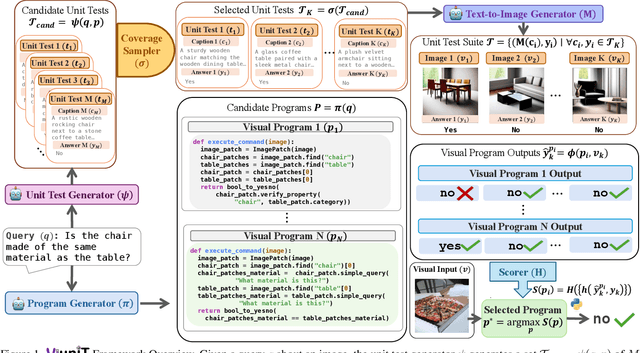
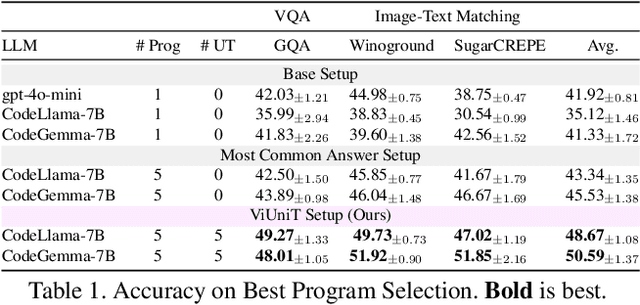
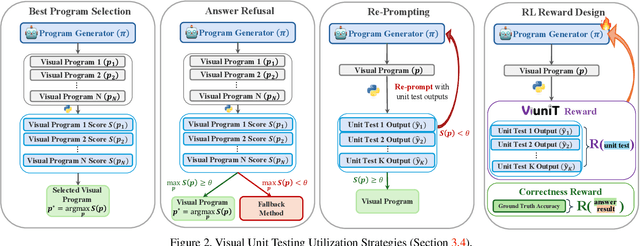
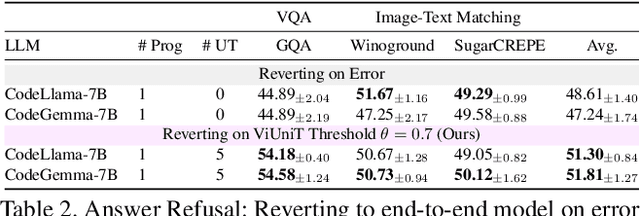
Abstract:Programming based approaches to reasoning tasks have substantially expanded the types of questions models can answer about visual scenes. Yet on benchmark visual reasoning data, when models answer correctly, they produce incorrect programs 33% of the time. These models are often right for the wrong reasons and risk unexpected failures on new data. Unit tests play a foundational role in ensuring code correctness and could be used to repair such failures. We propose Visual Unit Testing (ViUniT), a framework to improve the reliability of visual programs by automatically generating unit tests. In our framework, a unit test is represented as a novel image and answer pair meant to verify the logical correctness of a program produced for a given query. Our method leverages a language model to create unit tests in the form of image descriptions and expected answers and image synthesis to produce corresponding images. We conduct a comprehensive analysis of what constitutes an effective visual unit test suite, exploring unit test generation, sampling strategies, image generation methods, and varying the number of programs and unit tests. Additionally, we introduce four applications of visual unit tests: best program selection, answer refusal, re-prompting, and unsupervised reward formulations for reinforcement learning. Experiments with two models across three datasets in visual question answering and image-text matching demonstrate that ViUniT improves model performance by 11.4%. Notably, it enables 7B open-source models to outperform gpt-4o-mini by an average of 7.7% and reduces the occurrence of programs that are correct for the wrong reasons by 40%.
WithdrarXiv: A Large-Scale Dataset for Retraction Study
Dec 04, 2024



Abstract:Retractions play a vital role in maintaining scientific integrity, yet systematic studies of retractions in computer science and other STEM fields remain scarce. We present WithdrarXiv, the first large-scale dataset of withdrawn papers from arXiv, containing over 14,000 papers and their associated retraction comments spanning the repository's entire history through September 2024. Through careful analysis of author comments, we develop a comprehensive taxonomy of retraction reasons, identifying 10 distinct categories ranging from critical errors to policy violations. We demonstrate a simple yet highly accurate zero-shot automatic categorization of retraction reasons, achieving a weighted average F1-score of 0.96. Additionally, we release WithdrarXiv-SciFy, an enriched version including scripts for parsed full-text PDFs, specifically designed to enable research in scientific feasibility studies, claim verification, and automated theorem proving. These findings provide valuable insights for improving scientific quality control and automated verification systems. Finally, and most importantly, we discuss ethical issues and take a number of steps to implement responsible data release while fostering open science in this area.
StyleDistance: Stronger Content-Independent Style Embeddings with Synthetic Parallel Examples
Oct 16, 2024



Abstract:Style representations aim to embed texts with similar writing styles closely and texts with different styles far apart, regardless of content. However, the contrastive triplets often used for training these representations may vary in both style and content, leading to potential content leakage in the representations. We introduce StyleDistance, a novel approach to training stronger content-independent style embeddings. We use a large language model to create a synthetic dataset of near-exact paraphrases with controlled style variations, and produce positive and negative examples across 40 distinct style features for precise contrastive learning. We assess the quality of our synthetic data and embeddings through human and automatic evaluations. StyleDistance enhances the content-independence of style embeddings, which generalize to real-world benchmarks and outperform leading style representations in downstream applications. Our model can be found at https://huggingface.co/StyleDistance/styledistance .
MiRAGeNews: Multimodal Realistic AI-Generated News Detection
Oct 11, 2024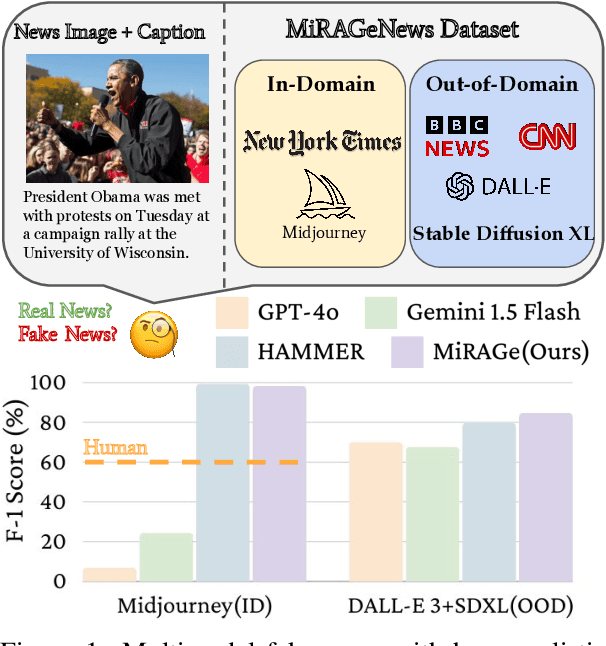
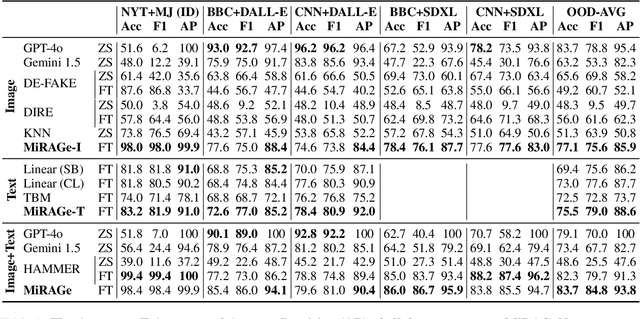
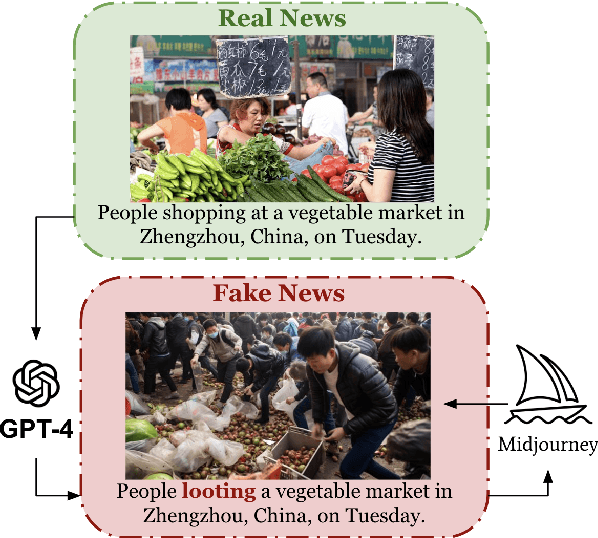
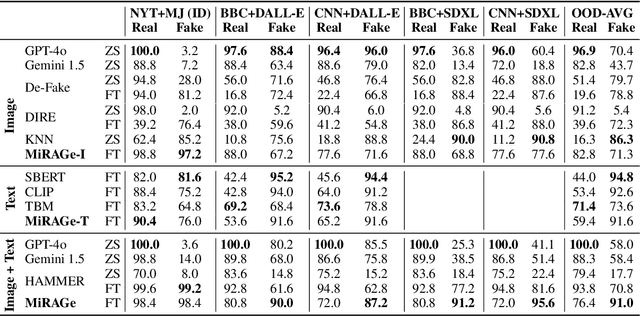
Abstract:The proliferation of inflammatory or misleading "fake" news content has become increasingly common in recent years. Simultaneously, it has become easier than ever to use AI tools to generate photorealistic images depicting any scene imaginable. Combining these two -- AI-generated fake news content -- is particularly potent and dangerous. To combat the spread of AI-generated fake news, we propose the MiRAGeNews Dataset, a dataset of 12,500 high-quality real and AI-generated image-caption pairs from state-of-the-art generators. We find that our dataset poses a significant challenge to humans (60% F-1) and state-of-the-art multi-modal LLMs (< 24% F-1). Using our dataset we train a multi-modal detector (MiRAGe) that improves by +5.1% F-1 over state-of-the-art baselines on image-caption pairs from out-of-domain image generators and news publishers. We release our code and data to aid future work on detecting AI-generated content.
 Add to Chrome
Add to Chrome Add to Firefox
Add to Firefox Add to Edge
Add to Edge